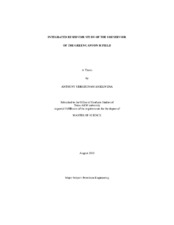| dc.description.abstract | The move into deeper waters in the Gulf of Mexico has produced new opportunities for petroleum production, but it also has produced new challenges as different reservoir problems are encountered. This integrated reservoir characterization effort has provided useful information about the behavior and characteristics of a typical unconsolidated, overpressured, fine-grained, turbidite reservoir, which constitutes the majority of the reservoirs present in the Outer Continental Shelf of the Gulf of Mexico.
Reservoirs in the Green Canyon 18 (GC 18) field constitute part of a turbidite package with reservoir quality typically increasing with depth. Characterization of the relatively shallow 8 reservoir had hitherto been hindered by the difficulty in resolving its complex architecture and stratigraphy. Furthermore, the combination of its unconsolidated rock matrix and abnormal pore pressure has resulted in severe production-induced compaction.
The reservoir's complex geology had previously obfuscated the delineation of its hydrocarbon accumulation and determination of its different resource volumes. Geological and architectural alterations caused by post-accumulation salt tectonic activities had previously undermined the determination of the reservoir's active drive mechanisms and their chronology.
Seismic interpretation has provided the reservoir geometry and topography. The reservoir stratigraphy has been defined using log, core and seismic data. With well data as pilot points, the spatial distribution of the reservoir properties has been defined using geostatistics. The resulting geological model was used to construct a dynamic flow model that matched historical production and pressure data..
The reservoir's pressure and production behavior indicates a dominant compaction drive mechanism. The results of this work show that the reservoir performance is influenced not only by the available drive energy, but also by the spatial distribution of the different facies relative to well locations. The study has delineated the hydrocarbon bearing reservoir, quantified the different resource categories as STOIIP/GIIP = 19.8/26.2 mmstb/Bscf, ultimate recovery = 9.92/16.01 mmstb/Bscf, and reserves (as of 9/2001) = 1.74/5.99 mmstb/Bscf of oil and gas, respectively. There does not appear to be significant benefit to infill drilling or enhanced recovery operations. | en |


